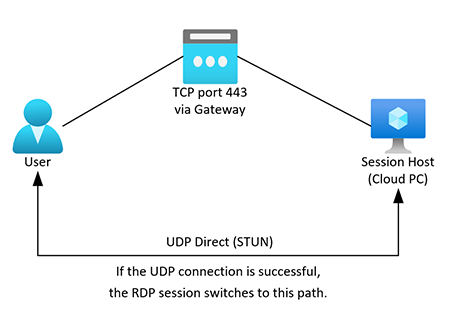Note
Access to this page requires authorization. You can try signing in or changing directories.
Access to this page requires authorization. You can try changing directories.
You can now use Remote Desktop Protocol (RDP) Shortpath for public networks with your Windows 365 Cloud PCs. RDP Shortpath for public networks can provide another connection path for improved Cloud PC connectivity, especially in suboptimal network conditions.
Requirements
To use RDP Shortpath for public networks with Windows 365, you must meet these requirements:
- Session Host (Cloud PC)
- UDP outbound to all public IP space (because, in most cases, it’s not possible to know the source IP address of the connecting PC).
- STUN server IP ranges on UDP port 3478.
- Client PC Network
- UDP outbound:
- To the public IP addresses assigned to Network Address Translation (NAT) gateway or the Azure Firewall in an Azure Hosted Network Scenario.
- For a Microsoft Hosted network scenario, all public IP spaces.
- UDP outbound:
Enable RDP Shortpath for public networks
To enable RDP Shortpath for public networks, visit the following Azure Virtual Desktop documentation page and follow the instructions:
Enable RDP Shortpath for public networks.
Verify UDP connectivity
UDP connectivity can be checked within the “Connection Information” section of a Remote session. For more information, see Verify RDP Shortpath is working.
RDP Shortpath benefits
The default connectivity to a Windows 365 Cloud PC is through a TCP connection that traverses a gateway using the reverse connect transport. The reverse transport means that there’s no need for inbound connectivity to the session host (Cloud PC) to connect RDP traffic.
RDP Shortpath enhances the TCP connection by providing an additional direct or relay-based connection between the Remote Desktop client and the Windows 365 Cloud PC using UDP. This improves connection reliability, reduces latency, and increases available bandwidth.

For more information about RDP Shortpath benefits, see Key benefits.
RDP Shortpath connection process
When you use RDP Shortpath, the connection with the Cloud PC proceeds as follows:
- The RDP connection establishes a TCP-based connection using the reverse connect transport through the Gateway (in the same way as it does for connectivity without RDP Shortpath).
- If RDP Shortpath is enabled on the session host (Cloud PC), the service creates a UDP socket on all viable network interfaces.
- To test connectivity, the service attempts to connect to a Windows 365 STUN server on the public internet through UDP port 3478. This step also establishes the external IP address of the NAT router.
- The session host’s candidate table lists the public IP and listener port that it has reachable connectivity on. This information is provided to the connecting client through the established TCP session.
- The client sends its list of reachable public IP addresses/ports to the session host.
- Both parties attempt a connection at the same time. Because both are creating outbound connections, it often allows connectivity to be established through firewalls because no inbound initiated connectivity occurs. If this connection is not established, then an indirect UDP connection is attempted using relay.
- If connectivity is successful, the service evaluates if the connection is the fastest path. If it is, all dynamic virtual channels (such as graphics, input, device redirection, and more) switch to the new transport flow.
Indirect UDP connection using TURN
By default, Indirect UDP connections using TURN is turned on for everyone. You can turn off UDP connections for public (and private) RDP Shortpath as described in POlicy CSP - ADMX_TerminalServer and set ADMX_TerminalServer/TS_SELECT_TRANSPORT to Use only TCP.
Known issues
The RDP Shortpath for public networks may not work with Cloud PCs where:
- Double NAT is in place. For example, if the traffic is routed through a Secure Web Gateway (SWG) or proxy where the connection uses a NAT twice (first, on egress from Azure and, second, from the VPN/SWG endpoint.)
- The connection is routed through an internet proxy or other inspection device.
- Any network that restricts UDP access or limits access to specific ports or IP ranges.
- Carrier Grade NAT (CGN) is used. Where the network shares a public IP address with other networks.
For more technical details on these scenarios, see How RDP Shortpath works.
Next steps
For complete information, see Azure Virtual Desktop RDP Shortpath for public networks.